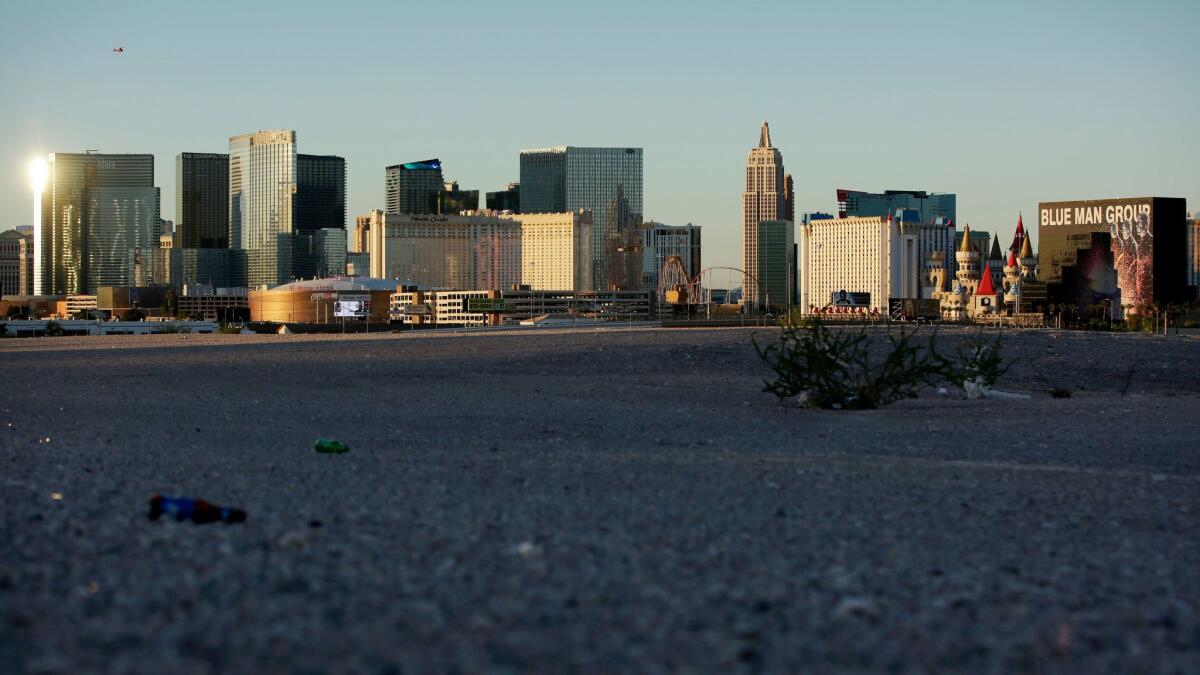Op-Ed: Deep down, Las Vegas isn’t ‘alien territory.’ It just plays that way in our imaginations

LAS VEGAS — On a hot and cloudless Sunday afternoon early last month, I took an architecture tour of the Las Vegas Strip. The setup was, in part, pure archetype: an open-air double-decker tour bus and a cooler of beer — Chamber of Commerce meets “Fear and Loathing.”
But that was the idea. Like Los Angeles, Las Vegas is a city both engaged and at odds with a sense of its own spectacle — “Bubbling, spiraling, rocketing, and exploding,” as Tom Wolfe wrote half a century ago, “in sunbursts ten stories high out in the middle of the desert.”
Does this mean Las Vegas gets a bad rap? Of course, it does — again, not unlike Los Angeles. The cities are very different, but this they share: The perception that they are shallow, without history or substance, that (to steal from Gertrude Stein) there is no there there.
Las Vegas was founded in 1905; before that, it was a Mormon supply depot. Gambling was legalized in 1931. Los Angeles has deeper roots, but the judgment is the same. Both places have dominant industries (gaming, entertainment) that are often written off as frivolous, despite their economic weight.
“A city 70 miles square but rarely 70 years deep,” Reyner Banham wrote about Los Angeles in 1971; adjust the numbers and he could be describing Las Vegas now.
The glow fades quickly when you live next door to the circus.
That architecture tour, however, traced the very real history of casinos, from Fremont Street to the Strip, addressing not only how they have succeeded, but also how they fail. One of the most compelling landmarks was the Fontainebleau, a 68-story casino hotel — the second tallest building in the city — abandoned before it was completed, catty-corner from the Stratosphere.
The Fontainebleau resonates both as urban ruin and as metaphor, a signifier of the limits of spectacle — or, more accurately, of what happens when things get real. It leaves us to ponder the complexity of a landscape we don’t want to imagine as complex.
I’ve been living in Las Vegas for the last few months, almost literally in the Fontainbleau’s shadow; I am on a semester-long fellowship at the University of Nevada, Las Vegas. Each day as I walk to campus, I see it: A shiny blue hulk that looks, at first glance, like another shrine to fantasy, until you make out the pockmarks of missing window glass. Even in a city commonly derided as all surface, we need to look closer if we want to understand what’s going on. What the Fontainbleau has to tell us is that illusion is a business and not every bet pays off.
A similar approach is required in Los Angeles. Both cities tend to hide their true dimensions, albeit in plain sight. Both bear the burden of glitz and flash, klieg lights and celebrity; both have portrayed themselves (not inaccurately) as exuberant American boom towns. Both seem so easily defined.
And yet, “easy definition” is an oxymoron, and perhaps especially in regard to Las Vegas, an urban landscape built in an inhospitable desert, where millions of people live and work, and where the Strip is visible from everywhere, but for residents anyway, not often a destination point.
Early in my stay, I made a plan to meet a friend for drinks. “Where do you want to go?” I asked. She replied: “Anywhere but the Strip.” The intention is one I recognize from Los Angeles. I can’t remember the last time I went to Hollywood or the Venice boardwalk, or thought there was anything glamorous about a movie premiere.
Partly, I suppose, that has to do with familiarity; the glow fades quickly when you live next door to the circus. But even more, the real life of cities takes place in the corners where no one is watching, where communities coalesce and develop, where the millions who call the place home interact at human scale, in everyday ways.
One of my favorite spots in Las Vegas is a little strip-mall bar that offers live-band karaoke; it’s mostly regulars in the late afternoon. Another is the stretch of UNLV that I walk on weekends, a mix of greenery and pathways like you’d find on any large campus, where South Asian students play a weekly cricket match and cinema majors shoot scenes for their films.
If I look up, I can see the other city: The ersatz Manhattan skyline of New York New York, the great green mass of the MGM Grand, the unfinished Fontainbleau. All day long, planes fly overhead, in and out of McCarran Airport.
This is the Las Vegas we think we understand, where the Strip and the airport sit adjacent to one another, as if there were nothing else. It’s axiomatic, as it is with Los Angeles, to frame the city through its spectacle, its glittering edge, if only because that allows us to accept the common gloss: This is a constructed place, entirely artificial, set apart from me and you and solid reality.
“Alien territory,” my father called it when I told him I’d be spending the winter and spring here. But in Las Vegas, as in Los Angeles, that phrase does not apply.
David L. Ulin is a contributing writer to Opinion.
Follow the Opinion section on Twitter @latimesopinionand Facebook.
More to Read
A cure for the common opinion
Get thought-provoking perspectives with our weekly newsletter.
You may occasionally receive promotional content from the Los Angeles Times.











